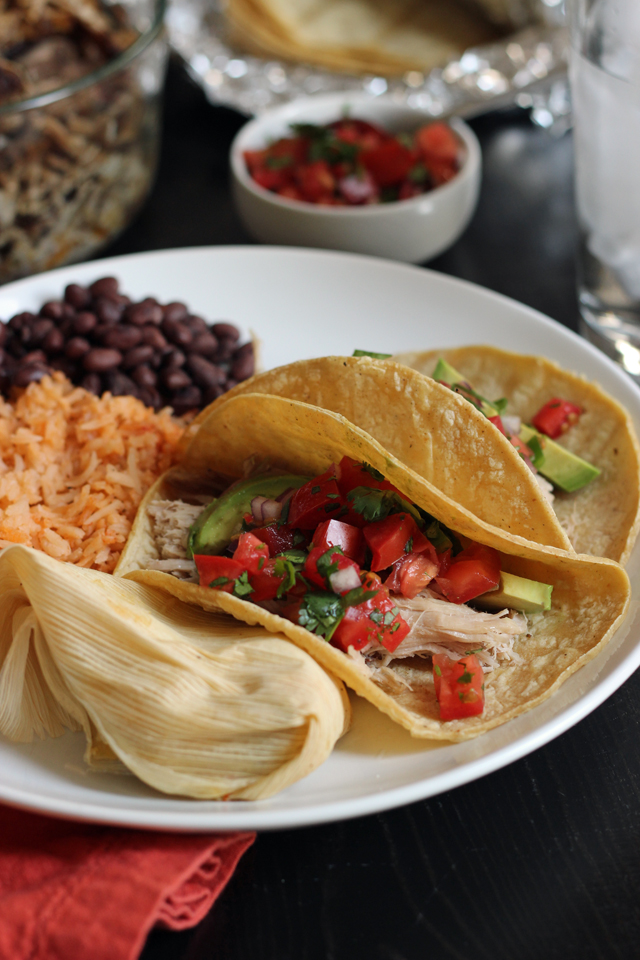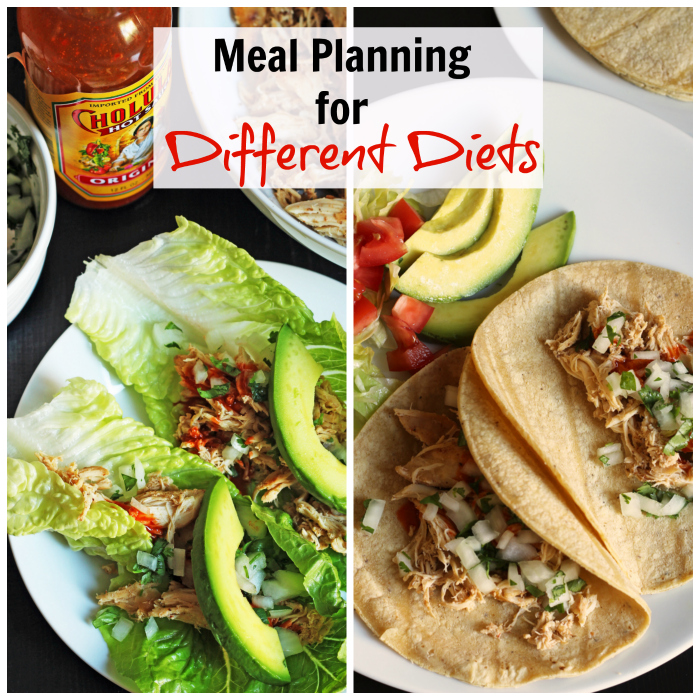Meal Planning for different diets can be tricky. What one person loves, the other hates or can’t eat. But, you don’t have to spend all day in the kitchen. There are ways to make it work to eat well and keep everyone happy.
Want to save this post?
Enter your email below and get it sent straight to your inbox. Plus, I'll send you budget recipes and money-saving tips every week!
Chicken Street Tacos
Getting a meal on the table every night can be tricky enough when you’re juggling budget and time concerns. If you throw in different dietary requirements and preferences for a small group of people, it can become a very complicated process.
Nut allergies, gluten-free, lactose intolerant, weight loss, paleo, vegan, the list goes on. There are so many different styles and preferences for eating — all legitimate, sometimes confusing.
But it’s not impossible!
In fact, there are plenty of families that deal with varied allergies and dietary issues, and yet they’re still able to come together for a meal every night without one or more people signing up as short order cooks.
Meal planning for different diets requires a little know-how and preparation, but once you get a system down, you can make it as easy as pie.
Meal Planning for Different Diets
Here are some strategies I’ve found to be helpful to serve a great meal when not everyone can or wants to eat the same thing.
Best Ever Slow Cooker Pulled Pork
1. Find common ground.
What are the foods that everyone in the household can enjoy? Make those more often.
It’s not terribly difficult to make adjustments to standard recipes for gluten-free, dairy-free, or even vegan preparation.
Vary the preparation style and perhaps the condiments, but focus on common ground. It’s more fun that way and no one gets left out.
Short of having the exact same meal, which isn’t always possible depending on dietary restrictions, find the overlap. Serve a main protein on different bases or with different toppings.
Is part of the family eating gluten-free? Serve burgers or chicken salad to everyone, but provide lettuce wraps for the folks eating gluten-free.
Does someone prefer a vegan diet? Make a big batch of chili or beans and rice with sides of meat and cheese for the carnivores.
Taco night? Make sure you serve grains, vegetables, and meat with all the toppings and sauces on the side. Then folks can pile their plates as they like. A Mexican food buffet can often serve a wide variety of diets without appearing to be different.
Consider these recipes and how you can serve them two (or more) ways:
- Hearty Gluten Free Meatballs – serve over pasta, polenta, and/or spaghetti squash
- Slow Cooker Beef Stew with Mushrooms and Olives – serve over rice, noodles, mashed potatoes, and/or cauliflower rice.
- Cajun Chicken Salad – serve on rolls, tortillas, a bed of greens, and/or lettuce wraps.
- Quinoa Chili with Three Chiles – serve with sides of cooked meat and cheese
- Beans and Rice: A Very Good Cheap Eat – naturally gluten free and can be adapted for a number of diets, depending on the toppings you serve.
Curry Chicken Salad Lettuce Wraps
2. Practice freezer cooking.
Freezer cooking is a great way to make meal planning for different diets not feel like drudgery every single night. Whenever you can, prepare homemade convenience foods so that everyone knows there will be something safe and pleasing to eat.
My friend, whose young son has celiac disease, prepares big batches of gluten-free cupcakes to freeze. Whenever he has a birthday party to go to or a family dinner, he has a special dessert that she knows he can enjoy safely.
If you’re going to tackle a Whole 30 while the rest of your family eats as they normally would, fill your freezer with Whole 30 foods without worrying about cooking two meals three times a day or being tempted to indulge in pizza with the rest of the family.
3. Purchase healthy convenience items where you can.
Let’s be realistic. If you’re meal planning for different diets, something has to give somewhere. While the ideal is certainly to make everything from scratch all the time, the reality is that is hard to do, short of making everyone fend for himself. That’s where a few healthy, purchased convenience items can help you bridge the gap between starvation or running yourself ragged in the kitchen.
Feel free to buy yourself some short cuts. Done is better than perfect, particularly where dinner is concerned.
4. Don’t spend more than you should.
It is a slippery slope to overspending when you’re shopping for different diets. Put some controls in place to make sure you don’t go above and beyond what your budget can handle.
- Plan meals based on what’s on sale or already in your cupboard.
- Stock up on low-priced items.
- Use up leftovers.
Want more help in saving money on food costs? When you subscribe to the free GCE newsletter, I’ll send you access to resources to help you enjoy great homemade meals with more time, money, and energy leftover for the life you love.
5. Ask for help.
When you can’t prepare one meal to suit everyone, don’t be afraid to ask for help as you make accommodations. Often times spouses and children seem to assume that the home cooks have it all together, when really you could use a little help! Let them know you need assistance; they can’t read your mind.
Where your folks are choosing their special diets (rather than having an allergy thrust upon them), be sure to communicate to them the challenges involved in making sure everyone is happy at the table. It’s possible they may be able to adjust some of their expectations to make it easier and less expensive for everyone.





janet
Dessert can be difficult if dairy and gluten are off the menu. I have found nearly everyone eats fruit. In the warmer months, grilled fruit is delicious. Provide honey or maple syrup for those that want to indulge in a drizzle over the top. In the cooler months, fruit poached in red or white wine is a favorite at our house. If alcohol is off the menu, pears poached in a mix of coffee, brown sugar and cardamom pods is good as is dried apricots poached in a mix of chamomile tea, honey and lemon peel. My kids like pears poached in a brown sugar syrup.
Jessica Fisher
Good point! And fruit is better for you and available all year round. Win!
Elizabeth "Beth" Pierson
I guess I get the “wicked witch” award for how I handled this problem, albeit I was fortunate that none of the family members had food allergies, etc. I was making 3-4 different meals every night, two different for each of my then 3 and 6 year old children, something for me having worked at least an 8 hour day in heels on marble floors and arriving home with a desperate wish to just go to bed. My husband was in a surgical residency program and coming home hungry and tired and not necessarily thrilled with my choices. I finally had a family meeting explaining that since I planned the meals, bought the groceries and fixed the meals, effective the next day everyone would be eating the same thing for dinner. If they didn’t like it, perhaps they would like the meal the next day. But, if they didn’t eat the first day, they would not be given alternative choices. The 3 of them grumbled a bit but by the 3rd evening, everyone was cleaning their plates. “Win Win” for everyone as my kids will eat anything put in front of them and have both become creative and great cooks!
Jessica Fisher
I call that Smart Mom, not Wicked Witch. It was a win-win all the way around and you’ve done your kids a favor not letting them picky.
I am sure you would have done things differently if it had been a food allergy or medical issue.
Molly
There was a cross-stitch sampler in my parents’ kitchen:
Sit down to the table
and have a look
the first complainer
is the next meal’s cook!
I am still grateful that my parents somehow finagled all of their children not to be picky eaters. Yes, we each have preferences (and some allergies/medical restrictions), but if somebody else is going to plan, shop, and cook, we do our best to appreciate it.
I’m also so grateful that my husband is not a picky eater – again, he has preferences, but he’s a-okay with leftovers, and that is a huge help.
Vickie
Thank you for this post, will take the tips to heart. I deal with a variety of health issues in our family of 5….3 type 2 diabetics, 1 type 1 diabetic, 1 high protein, low phosporus, low potassium, one low protein. I’m grateful for the new ideas. Thanks!
Jessica Fisher
Let me know how it goes. I’m cheering you on!
Alice E
This is timely for me, since I have had to be very careful about diet, especially fat due to medical issues since the first part of April. With just two of us, it wasn’t too complicated, but it did get involved. You have very good ideas for coping. We ate a lot of baked potatoes, mine frequently plain or with fat free cottage cheese. Thankfully I don’t need to be quite as careful as time goes by.
Jessica Fisher
Glad you’re clearing some things up healthwise, Alice. Sounds like you’ve got a good strategy going!
Janet
I accommodate all medical issues. We have a family member with a gluten allergy and another with Type I diabetes. Their food needs are not choices, but necessities. Preferences will be noted, but not always accommodated. We have extended family members who are Jewish and therefore do not eat pork, another who is vegetarian, and another who claims to be lactose intolerant, but always joins in when ice cream is on the menu. At Christmas I had all these people under my roof for 5 days. Following all these restrictions would have meant no meat, no dairy, no sugar, no wheat and a very grumpy cook.
My youngest is now 13, so everyone is old enough to cook for themselves. I am not running a restaurant. If you do not want what I have cooked my response is, you know where the kitchen is, knock yourself out. And do not get me started on the kid’s friends and their expectations! I have had children ask me point blank to cook them something else because they didn’t like what I was serving. Whatever happened to being a gracious guest?
I am weary of picky eaters. I expect that from children, but now the adults are just as bad if not worse.
Jessica Fisher
I could totally picture all those people at your house at Christmas. There’s no way you could cater to every preference. Oh my! BYOEverything!
Kristie Speakman
I love this post! I have two toddlers with different aversions, a semi-veggiephobic husband and personally trying to eat low calorie, whole foods. Oh, and I try to do only one big shopping trip a month plus one run for milk and produce. Trying to figure it all out can be mind boggling. My solution is to feed the kids a lot of “deconstructed” meals, I let them eat the ingredients separately. It works well for us.
Jessica Fisher
Great strategy to help everyone enjoy their dinner!
Jan
Excellent tips Jessica! I’ve gotten much more serious with the meal prep work over the weekend to make life a little easier so I can make sure that I’m eating what I feel is good for ME while the rest of the family can have what they consider “traditional” I.e. I try to avoid grains and dairy for the most part, although not always successful, but if I plan ahead, it’s a lot easier! 😉
Jessica Fisher
Yes! That weekend work can produce such great dividends!
Joshua Hampton
The timing of this post couldn’t be better. One of my boys turned picky overnight for some reason and I think your tips will help me a lot.
Jessica Fisher
Don’t you love it when that happens?
Katie
Loved this post! This topic is never far from my mind! In have a five year old son with eosinophilic esophagitis (an allergic disease that severely limits his available safe foods). However, we are also a family of nine, so I’ve found keeping my son’s safe alternatives in the freezer to be the best solution. One tip, when meal planning, I always add a side note for any details I might forget when busy making dinner for the rest of the family (I.E. Adding a fresh side or leaving off seasoning in a portion of the main dish).
Jessica Fisher
Great tip!